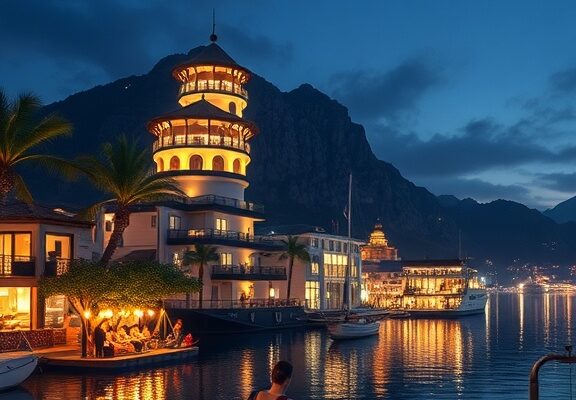The Best Time to Visit Iceland to See Northern Lights: A Seasonal Breakdown
When you think of Iceland, the breathtaking Northern Lights come to mind. This magical phenomenon attracts many travelers hoping to witness the enchanting dance of colors in the winter skies. To maximize your chances of seeing these lights, timing plays a crucial role. Let’s delve into the best times to visit Iceland for the ultimate Northern Lights experience.
Thank you for reading this post, don't forget to subscribe!September to October: The Glittering Beginning
The Northern Lights season in Iceland typically kicks off in September. As the summer days fade away, the skies turn darker, creating perfect conditions for the auroras to appear. During this time, you can enjoy a unique blend of warm weather and cooler nights. Plus, the landscape is still vibrant and green from summer, offering a beautiful backdrop for your Northern Lights adventure.
Here are a few reasons why visiting in early autumn is ideal:
- Fewer crowds: September and October are less busy than peak winter months, allowing for a more serene experience.
- Milder temperatures: Enjoy temperatures that hover above freezing, making it easier to explore during the day.
- Daylight hours: You still have some daylight for sightseeing before the long polar nights set in.
November to March: The Peak Viewing Season
Winter months from November to March are renowned for their excellent Northern Lights visibility. This is when the nights become longer and darker, perfect for spotting this celestial display. The skies are clearest during these months, as the weather can be very cold and dry.
During this period, the auroras are often more vibrant and frequent. It’s not uncommon to witness several shows in a single night! However, be prepared for a few additional challenges:
- Frigid temperatures: Dress warmly, as temperatures can plunge well below freezing.
- Unpredictable weather: While the chance of seeing Northern Lights is high, cloudy skies can obscure your view.
- Tour availability: Many tours run during this peak season, providing various options for exploration.
April: The Tail End of the Season
After a lengthy winter, by April, the Northern Lights season begins to wind down. However, it’s still possible to catch a glimpse of this natural wonder, especially in early April. As the month progresses, daylight increases, diminishing the chances of spotting the auroras.
Reasons to consider an April visit include:
- Spring temperatures: Warmer conditions make it more comfortable to explore during the day.
- Longer days: Enjoy daylight for sightseeing, even if the nights are shorter.
- A lesser crowd: Fewer tourists take advantage of this time, making for a more relaxed experience.
Tips for Optimal Aurora Viewing
While selecting the right time is essential, there are additional tips to ensure you have an unforgettable Northern Lights experience:
- Choose a dark location: Get away from city lights for the best views; places like Thingvellir National Park or Snaefellsnes Peninsula are excellent choices.
- Stay flexible: Keep your travel plans adaptable; sometimes, the lights may surprise you at unexpected times!
- Check aurora forecasts: Use online tools or apps that provide real-time updates on the aurora activity and cloud cover to increase your chances of seeing the lights.
The best time to visit Iceland for the Northern Lights is subjective and can depend on your preferences for weather, crowd levels, and available activities. Whether you go in the heart of winter or at the beginning of autumn, witnessing the Northern Lights will surely be a highlight of your travel journey!
Tips for Maximizing Your Northern Lights Experience in Iceland
Experiencing the mesmerizing Northern Lights in Iceland is a dream for many. If you’re planning to catch a glimpse of this natural wonder, here are some tips to enhance your adventure and ensure you have the best chance of witnessing this breathtaking phenomenon.
Timing Your Visit
The best time to visit Iceland for the Northern Lights is during the winter months, specifically from late September to mid-April. This time frame offers the longest nights and the best chance of clear skies. You should keep an eye on solar activity as well, as higher solar wind speeds can lead to more vibrant displays.
Choosing Locations
While Reykjavik is a popular base, you should venture out to darker areas for optimal viewing. Here are some ideal places:
- Thingvellir National Park: A UNESCO World Heritage Site, this park offers stunning landscapes and dark skies.
- Jökulsárlón Glacier Lagoon: The reflective waters add to the beauty of the Aurora.
- Akureyri: This northern town has fewer light pollution issues and scenic vistas.
- Snaefellsnes Peninsula: Offers a mix of mountains, coastlines, and open skies for an unforgettable experience.
Staying Informed
Stay updated on weather forecasts and Aurora activity. Websites and apps like the Icelandic Met Office provide real-time alerts about Northern Lights visibility. Joining local Facebook groups or following tourism boards can also offer valuable insights from other travelers.
Preparing for the Cold
Dress in layers to ensure you stay warm while waiting for the lights to appear. Some essential clothing items include:
- Warm Thermal Layers
- Insulated Jacket
- Waterproof Pants
- Warm gloves and a hat
- Sturdy, insulated footwear
Being comfortable in the cold allows you to enjoy your Northern Lights experience for longer without distractions.
Using the Right Equipment
To capture the Northern Lights effectively, you need a camera that allows manual adjustments. Here are some tips for optimal photography:
- Use a Tripod: This stabilizes your camera for long exposure shots.
- Adjust Your Settings: Use a high ISO, wide aperture (f/2.8 or lower), and longer shutter speeds (15-30 seconds).
- Remote Shutter Release: This helps prevent camera shake when taking photos.
Be Patient and Open-Minded
Sometimes the Northern Lights may not behave as expected. Visibility can be unpredictable. Be prepared for some waiting. Bring warmth, snacks, and perhaps a good book to pass the time as you enjoy the night sky. Even if you don’t see the lights, Iceland’s stunning scenery offers a rewarding experience.
Consider a Guided Tour
If you’re new to the area or unsure about the best spots to see the Northern Lights, consider joining a guided tour. Experienced guides are familiar with local conditions and know where to take you for the best views. Some tours also offer photography assistance, ensuring you capture the moment perfectly.
Stay Flexible
Weather conditions can change rapidly in Iceland. It’s essential to stay flexible with your plans and remain open to rescheduling your Northern Lights viewing nights based on weather forecasts. Staying adaptable maximizes your chances of seeing the Aurora Borealis.
Enjoy the Experience
Remember to take a moment to appreciate the beauty around you. The Northern Lights create an atmosphere of wonder and excitement. Take deep breaths, soak in the environment, and let yourself be captivated by this natural spectacle. Whether you firm up plans or opt for spontaneous explorations, the journey to see the Northern Lights will undoubtedly be a highlight of your Icelandic adventure.
Conclusion
Iceland offers an unforgettable opportunity to witness the mesmerizing northern lights, and timing your visit can significantly enhance this experience. By considering the seasonal breakdown, you can identify the prime months for spotting the auroras. Late September to mid-April provides the best chances, with darkness and weather conditions aligning to create a perfect viewing environment.
Additionally, knowing when to go is just the beginning. Maximizing your northern lights experience involves preparation and a bit of strategy. Staying flexible with your plans and checking local aurora forecasts can lead you to the optimum viewing locations on clear nights. Opt for guided tours that specialize in northern lights chases, as they are familiar with the best spots and conditions, ensuring you have a greater chance of catching these spectacular sights.
Think about the areas you choose to explore while in Iceland as well. North and West regions, away from city lights, often offer clearer views. Embrace the experience fully; dress warmly, apply patience, and immerse yourself in the natural beauty surrounding you.
When you align your visit with optimal viewing times and arm yourself with practical tips for maximizing your adventure, you’ll create lasting memories under the enchanting auroras. The dance of the northern lights is a phenomenon like no other, and with the right planning, it can become the highlight of your Iceland trip. Getting to witness this magic is an experience you’ll cherish for a lifetime.






